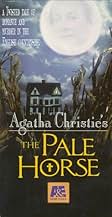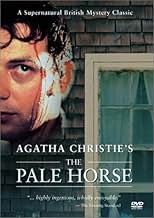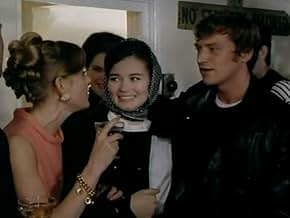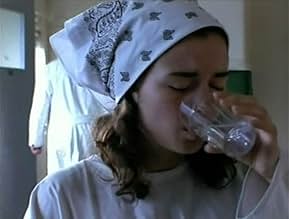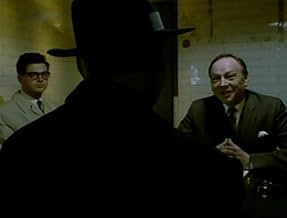Agrega una trama en tu idiomaWhen Mark Easterbrook finds himself in the frame for the murder of a priest, there seems no way to prove his innocence other than solving the mystery himself.When Mark Easterbrook finds himself in the frame for the murder of a priest, there seems no way to prove his innocence other than solving the mystery himself.When Mark Easterbrook finds himself in the frame for the murder of a priest, there seems no way to prove his innocence other than solving the mystery himself.
- Dirección
- Guionistas
- Elenco
Richard O'Callaghan
- Donald
- (as Richard O' Callaghan)
- Dirección
- Guionistas
- Todo el elenco y el equipo
- Producción, taquilla y más en IMDbPro
Opiniones destacadas
This would have been better without some completely pointless changes brought in to the plot. At the start there is a completely implausible attempt to suggest that Mark is suspected of being the killer. Nothing in the show suggests the police would suspect him in this way and the plot line dies quietly, having wasted a fair amount of time. Most of the performances are adequate at worst but the dialogue is often poor. One of the things which made the book successful was the way it at least played with the idea of the supernatural. No one could be fooled by the witches here. Agatha Christie was usually luckier than this in her adaptors for the screen.
A lesser Christie story in a distinctly lesser adaptation.
The trouble starts with "The 60s". Christie published the book in 1961 but was still writing classic Christie-style stories that really only work to their best in a pre-war setting as per Suchet-Poirot. Hickson-Marple got away with the 50s by pretending little had changed since the 30s (and had the sense to set the 60s Marples in their version of the 50s alongside the others) but in both cases the result was the same: a comforting historical atmosphere that can make some poor plotting and characters forgiveable. But few people have charming fantasies about the 60s so the story has to hold the attention that much more securely: a tough job even with a major story and/or well-loved characters, both of which this film lacks.
The attempt at doing the 60s in this case is also pretty ham-fisted: book 1961, coffin lid 1964, mini dresses and knee boots scream 1967; hospital bedside electronics suggests 80s at least.
So with no convincing period atmosphere to fall back on, the weak plot with too few suspects and too many gaps is laid rather bare.
Even given these issues, all might not have been lost with stronger main characters but Colin Buchanan is simply not leading material. Jayne Ashbourne is arrestingly pretty and her easy naturalness could have made a great contribution given a powerful male lead and more dynamic script but as it is she just hovers unproductively.
In summary, it is watchable despite rather than because of itself but could have been much better for the same money if the producers had simply used a bit of common sense, set it in 1997, and spent the mini-skirt budget on a better leading man and a decent script editor.
The trouble starts with "The 60s". Christie published the book in 1961 but was still writing classic Christie-style stories that really only work to their best in a pre-war setting as per Suchet-Poirot. Hickson-Marple got away with the 50s by pretending little had changed since the 30s (and had the sense to set the 60s Marples in their version of the 50s alongside the others) but in both cases the result was the same: a comforting historical atmosphere that can make some poor plotting and characters forgiveable. But few people have charming fantasies about the 60s so the story has to hold the attention that much more securely: a tough job even with a major story and/or well-loved characters, both of which this film lacks.
The attempt at doing the 60s in this case is also pretty ham-fisted: book 1961, coffin lid 1964, mini dresses and knee boots scream 1967; hospital bedside electronics suggests 80s at least.
So with no convincing period atmosphere to fall back on, the weak plot with too few suspects and too many gaps is laid rather bare.
Even given these issues, all might not have been lost with stronger main characters but Colin Buchanan is simply not leading material. Jayne Ashbourne is arrestingly pretty and her easy naturalness could have made a great contribution given a powerful male lead and more dynamic script but as it is she just hovers unproductively.
In summary, it is watchable despite rather than because of itself but could have been much better for the same money if the producers had simply used a bit of common sense, set it in 1997, and spent the mini-skirt budget on a better leading man and a decent script editor.
We rented this expecting to have a cozy evening at home. I came away very disappointed. Most Agatha Christie adaptations are very good, and I was not familiar with this particular story. The first 15 minutes promise an entertaining experience, but then it more or less runs off the tracks.
The writing is pretty poor and should have provided additional exposition. Watching this was like reading a novel and skipping the even numbered chapters. I had only a faint clue as what was going on and could not figure out why the characters were doing or why they were doing it, mostly the latter.
In the future, I will stick to the Hercule Poirot or Miss Marple stories. With them, you know what you are getting and won't be disappointed.
The writing is pretty poor and should have provided additional exposition. Watching this was like reading a novel and skipping the even numbered chapters. I had only a faint clue as what was going on and could not figure out why the characters were doing or why they were doing it, mostly the latter.
In the future, I will stick to the Hercule Poirot or Miss Marple stories. With them, you know what you are getting and won't be disappointed.
After Sarah Phelps' butchering of the story, I was hoping this adaptation was better...
It isn't.
A lot is ommited from the book (as usual with any adaptation that isn't Agatha Christie's Poirot, which makes changes but always keep the core of the story intact), including the best character- Mrs. Oliver.
In this one, Mark witnesses the murder and puts himself in the frame, then (reluctantly) investigates to find the real killer.
Our first issue, beyond the budgetary constraints that makes the supposedly 60s setting feel token and badly done, is Mark himself. Our hero is pretty dim here, obstinate, and kind of a moron. Even though he's in the frame and a supposed artist (he doesn't seem to know anything about art), he refuses to believe anyone telling him that the other deaths are connected.
Next we have the cops, who are complete idiots on the level of a Monty Python sketch, complete with Andy Serkis with ridiculous hair and a chief inspector that constantly looks to camera with a devilish smile. I realise cops in reality are probably this inept sometimes, but I doubt they look to camera and grin about it.
Everything else just annoyed me. I think it is Mark's attitude throughout, a kind of cooler than thou attempt at James Dean that falls flat.
He looks so disinterested and dismissive, sulking his way through scenes as if his life doesn't hang in the balance.
And the rest of acting is more panto than murder mystery. Even Serkis is bad.
The women fare a lot better, with better acting from them. None of it saves the adaptation, though, which would have been a lot better if they'd stuck to the book more.
It isn't.
A lot is ommited from the book (as usual with any adaptation that isn't Agatha Christie's Poirot, which makes changes but always keep the core of the story intact), including the best character- Mrs. Oliver.
In this one, Mark witnesses the murder and puts himself in the frame, then (reluctantly) investigates to find the real killer.
Our first issue, beyond the budgetary constraints that makes the supposedly 60s setting feel token and badly done, is Mark himself. Our hero is pretty dim here, obstinate, and kind of a moron. Even though he's in the frame and a supposed artist (he doesn't seem to know anything about art), he refuses to believe anyone telling him that the other deaths are connected.
Next we have the cops, who are complete idiots on the level of a Monty Python sketch, complete with Andy Serkis with ridiculous hair and a chief inspector that constantly looks to camera with a devilish smile. I realise cops in reality are probably this inept sometimes, but I doubt they look to camera and grin about it.
Everything else just annoyed me. I think it is Mark's attitude throughout, a kind of cooler than thou attempt at James Dean that falls flat.
He looks so disinterested and dismissive, sulking his way through scenes as if his life doesn't hang in the balance.
And the rest of acting is more panto than murder mystery. Even Serkis is bad.
The women fare a lot better, with better acting from them. None of it saves the adaptation, though, which would have been a lot better if they'd stuck to the book more.
This is a 1997 version of "The Pale Horse," based on the 1961 novel of the same name by Agatha Christie.
Ariadne Oliver is in the book, but she's not in this production.
The story concerns a sculptor, Mark Easterbrook, who finds a priest dying in an alley. The priest has a list of names. When the police arrive, they take the list away from Easterbrook and accuse him of murder.
He and an art restorer, Kate Mercer, work to prove his innocence, using whatever Mark remembers of the list. He's shocked to learn that everyone on the list is dead, save one, and all from natural causes.
Mark and Kate are led to a house called "The Pale Horse," where three women who claim to be witches live. Can their spells actually kill people? What about the booking agent Mark meets? Can he think someone dead, or does he set it up? This could have been a more interesting story, but it isn't, due to the fact that it's somewhat confusing. Also, while some of the women's clothing appears to be from the '60s, nothing else seemed very '60s to me with Easterbrook walking around wearing a leather jacket. The era is amorphous.
The acting was okay. I enjoyed seeing Hermoine Norris in a different kind of role from the one she played on MI-5 and her character on Wire in the Blood. She was very good. Also, Michael Byrne and Leslie Phillips give outstanding performances. The rest of the acting was so-so, as were the production values.
After watching the Hercule Poirot series, it's hard to go back to anything less than the characterizations, production values, and costumes found in them.
Ariadne Oliver is in the book, but she's not in this production.
The story concerns a sculptor, Mark Easterbrook, who finds a priest dying in an alley. The priest has a list of names. When the police arrive, they take the list away from Easterbrook and accuse him of murder.
He and an art restorer, Kate Mercer, work to prove his innocence, using whatever Mark remembers of the list. He's shocked to learn that everyone on the list is dead, save one, and all from natural causes.
Mark and Kate are led to a house called "The Pale Horse," where three women who claim to be witches live. Can their spells actually kill people? What about the booking agent Mark meets? Can he think someone dead, or does he set it up? This could have been a more interesting story, but it isn't, due to the fact that it's somewhat confusing. Also, while some of the women's clothing appears to be from the '60s, nothing else seemed very '60s to me with Easterbrook walking around wearing a leather jacket. The era is amorphous.
The acting was okay. I enjoyed seeing Hermoine Norris in a different kind of role from the one she played on MI-5 and her character on Wire in the Blood. She was very good. Also, Michael Byrne and Leslie Phillips give outstanding performances. The rest of the acting was so-so, as were the production values.
After watching the Hercule Poirot series, it's hard to go back to anything less than the characterizations, production values, and costumes found in them.
¿Sabías que…?
- ErroresA few lines of dialogue use expressions from the 90s, and wouldn't have been known in the 60s. Most prominent example is Corrigan's saying "Enjoy!"
- Citas
Thyrza Grey: Only death solves all problems; only death gives true peace. Death is the great ecstasy.
- ConexionesReferences Lolita (1962)
Selecciones populares
Inicia sesión para calificar y agrega a la lista de videos para obtener recomendaciones personalizadas
Detalles
- Fecha de lanzamiento
- País de origen
- Idiomas
- También se conoce como
- El misterio de Pale Horse
- Locaciones de filmación
- Productoras
- Ver más créditos de la compañía en IMDbPro
Contribuir a esta página
Sugiere una edición o agrega el contenido que falta

Principales brechas de datos
By what name was The Pale Horse (1997) officially released in Canada in English?
Responda
